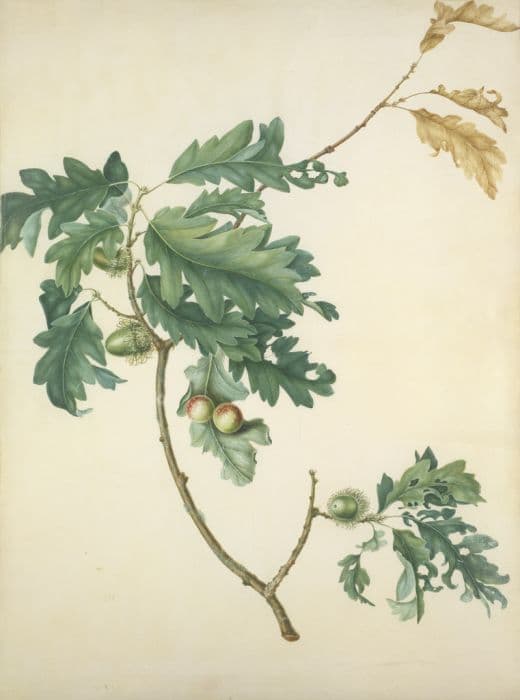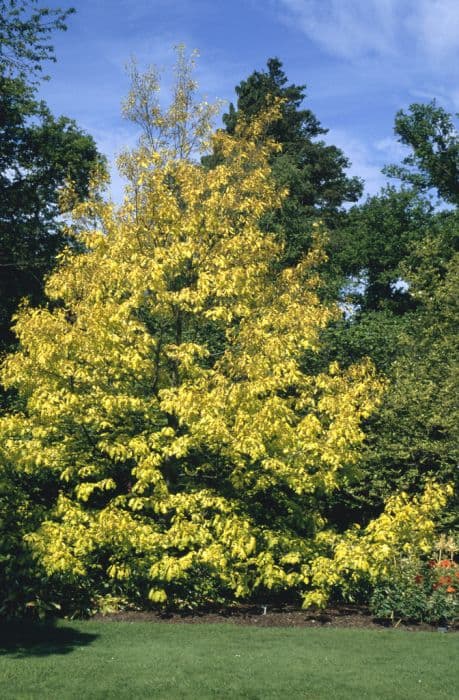Ring-cupped Oak Quercus glauca

ABOUT
The plant known commonly as the Blue Japanese Oak is a visually striking evergreen species. It is characterized by a dense, rounded crown of glossy dark green leaves that have a bluish tinge on their undersides, giving it the 'blue' reference in its common name. These leaves are oblong to elliptical in shape, with wavy margins and a leathery texture. The leaf arrangement is simple and alternate, providing a sleek, layered look to the foliage. Throughout the year, the Blue Japanese Oak's appearance is quite steadfast due to its evergreen nature. However, it does produce inconspicuous flowers, followed by acorns that are a telltale marker of its family. The acorns are borne on lengthy stalks and have a smooth, woody cap that covers part of the nut. The bark of the Blue Japanese Oak is another distinctive feature, boasting a rough texture and a greyish-brown color that can help the tree stand out in a forested backdrop. It adds to the overall robust and rugged aesthetic of the plant. The tree's form is often straight and upright, contributing to its dignified presence in the landscape. In summary, the Blue Japanese Oak sports a lush canopy with bluish-green leaves, bears subtle flowers and notable acorns, and is supported by a distinctively textured trunk. Its evergreen nature ensures that it maintains its appearance across seasons, offering a consistent and striking visual interest.
About this plant
 Names
NamesSynonyms
Blue Japanese Oak, Ring-Cupped Oak, Japanese Blue Oak, Japanese Evergreen Oak.
Common names
Cyclobalanopsis glauca, Quercus acutissima, Quercus bambusifolia, Quercus bengalensis, Quercus dealbata, Quercus harae, Quercus myrsinifolia, Quercus neglecta, Quercus phillyraeoides, Quercus serrata, Quercus thunbergii, Quercus wutaishanica
 Toxicity
ToxicityTo humans
The common name for Quercus glauca is Ring-Cupped Oak. There are over 500 species of oak trees, and while acorns and oak leaves can sometimes cause issues for humans if ingested in large quantities due to the presence of tannins and other compounds like phenolics, the toxicity is generally low. The symptoms of oak poisoning typically include stomach pain, vomiting, diarrhea, and rarely, kidney damage due to the long-term ingestion of large amounts of oak material. The toxicity of Ring-Cupped Oak to humans is not commonly reported, but it is advisable to avoid ingestion of parts of any oak tree to prevent any potential adverse effects.
To pets
The Ring-Cupped Oak's toxicity carries over to pets, with concern primarily related to the ingestion of acorns or leaves. Dogs, cats, and horses, can experience oak toxicity. Symptoms in pets, primarily in dogs and horses, can include abdominal pain, vomiting, diarrhea, and lethargy. In more severe cases, it may lead to kidney damage due to the high tannin content. If a pet ingests a substantial amount of acorns or oak leaves, it is important to seek veterinary attention, as early treatment can prevent more serious complications.
 Characteristics
CharacteristicsLife cycle
Perennials
Foliage type
Evergreen
Color of leaves
Green
Flower color
Yellowish-green
Height
20-30 feet (6-9 meters)
Spread
15-20 feet (4.5-6 meters)
Plant type
Tree
Hardiness zones
7
Native area
Asia
Benefits
 General Benefits
General Benefits- Ecosystem Support: Quercus glauca provides habitat and food for a variety of wildlife, including insects, birds, and small mammals.
- Shade and Cooling: Its canopy offers shade, creating cooler microclimates which can be beneficial in urban and garden settings.
- Soil Improvement: The leaves and bark decompose to enrich the soil with organic matter, improving soil quality and structure.
- Erosion Control: Its root system helps stabilize soil and prevent erosion, especially on slopes and banks.
- Aesthetic Value: With its evergreen foliage and attractive form, Quercus glauca is often used in landscaping for ornamental purposes.
- Carbon Sequestration: As a large perennial tree, it absorbs carbon dioxide, contributing to the mitigation of climate change.
- Wood Production: Quercus glauca wood is valued for its durability and is used in construction and furniture making.
 Medical Properties
Medical Properties- Anti-inflammatory: Compounds in Quercus glauca may help reduce inflammation.
- Antidiarrheal: The plant has been used to treat diarrhea.
- Antimicrobial: It has properties that may inhibit the growth of certain bacteria and fungi.
- Astringent: The bark is considered to have astringent properties, which can help to tighten tissues and reduce secretions.
- Hemostatic: Traditionally, it may have been used to stop bleeding.
- Liver protection: There is some suggestion that the plant may have hepatoprotective effects.
 Air-purifying Qualities
Air-purifying QualitiesThis plant is not specifically known for air purifying qualities.
 Other Uses
Other Uses- Quercus glauca, commonly known as the blue Japanese oak, has durable wood that can be used in furniture making and interior joinery, offering a sturdy and aesthetic quality to household furnishings.
- The acorns of blue Japanese oak can be processed to make a flour substitute which, after leaching out tannins, can be used in cooking for those interested in foraging and traditional food practices.
- The tree's bark has been used historically in tanning leather, with the tannins it contains helping to convert animal hides into durable leather goods.
- Wood from blue Japanese oak can be utilized in the construction of traditional Japanese buildings, valued for its strength and resistance to rot.
- Blue Japanese oak makes excellent firewood due to its ability to burn hot and slow, providing warmth and a cooking heat source in rural areas.
- Leaves of the blue Japanese oak serve as good litter material for composting, enriching the soil with organic matter as they decompose.
- Quercus glauca can be used in bonsai cultivation, with enthusiasts appreciating its leaf size and bark texture for creating miniature landscapes.
- The wood can also serve as raw material for the production of wood chips used in gardening and landscaping to suppress weeds and retain soil moisture.
- The dense canopy of blue Japanese oak provides shade in coffee plantations, sheltering the understory crops from intense sunlight and helping to create a suitable microclimate for coffee growth.
- Acorns of the blue Japanese oak, once leached of tannins, are used in some Asian cuisines to create acorn jelly, known as dotorimuk in Korean cuisine, which is a traditional dish with a unique texture.
Interesting Facts
 Feng Shui
Feng ShuiThe Ring-cupped oak is not used in Feng Shui practice.
 Zodiac Sign Compitability
Zodiac Sign CompitabilityThe Ring-cupped oak is not used in astrology practice.
 Plant Symbolism
Plant Symbolism- Strength: As a species of oak tree, Quercus glauca, commonly known as the Ring-Cupped Oak, embodies the universal symbolism of oaks as icons of durability and endurance.
- Longevity: Ring-Cupped Oaks can live for hundreds of years, representing the ability to withstand the test of time.
- Wisdom: In various cultures, oaks are considered wise due to their old age and the intricate ecosystems that thrive within them.
- Resilience: The Ring-Cupped Oak exhibits remarkable resilience, adapting to various climates, symbolizing the ability to persevere through challenges.
- Nobility: Oaks have often been associated with nobility and royalty, and Quercus glauca shares this representation due to its majestic presence.
- Stability: The strong roots of the Ring-Cupped Oak mirror the idea of stability and being grounded in one's life or beliefs.
 Water
WaterThe Ring-cupped Oak should be watered deeply, roughly once a week, providing approximately 1-2 gallons of water. During the growing season, it's essential to maintain moist but not soggy soil, allowing the top couple of inches to dry out between waterings. In winter, reduce watering frequency to when the soil is dry to touch several inches deep as the tree's water requirements decrease significantly during dormancy.
 Light
LightThe Ring-cupped Oak thrives in full sun to partial shade, preferring at least 4-6 hours of direct sunlight each day. The ideal spot is one where the tree receives morning sunlight and some afternoon shade, especially in hotter climates, to protect it from the intense late-day rays.
 Temperature
TemperatureThe Ring-cupped Oak is hardy and can withstand a broad range of temperatures. It survives in temperatures as low as 20°F and as high as 100°F. The ideal temperature range for optimal growth is between 60°F and 80°F.
 Pruning
PruningPruning the Ring-cupped Oak is mostly for shape, health, and to remove any dead or damaged branches. The best time to prune is in late winter or early spring before new growth begins. Prune sparingly, removing only what is necessary, and aim to do this annually or biannually to maintain tree vigor and appearance.
 Cleaning
CleaningAs needed
 Soil
SoilThe Ring-cupped Oak (Quercus glauca) prefers well-draining, acidic to neutral soil with a pH range of 5.0-7.5. A good soil mix contains leaf mold, garden compost, and sharp sand to improve drainage. Mulching with organic material can help maintain soil moisture and provide nutrients.
 Repotting
RepottingRing-cupped Oaks are slow-growing trees and do not need to be repotted frequently. Young trees can be repotted every 2-3 years, while mature trees may only need repotting every 4-5 years to refresh the soil and check root growth.
 Humidity & Misting
Humidity & MistingRing-cupped Oak thrives in moderate to high humidity levels. Although it is adaptable, aiming for humidity levels between 50-70% is ideal to mimic its natural environment.
 Suitable locations
Suitable locationsIndoor
Ensure enough light, room to grow, and good air circulation.
Outdoor
Plant in a sunny location with space for roots and canopy.
Hardiness zone
7-10 USDA
 Life cycle
Life cycleThe life of the Quercus glauca, commonly known as the Ring-cupped Oak, begins with an acorn, which is its seed stage. Once the acorn germinates, it enters the seedling stage, during which roots establish in the soil and a shoot emerges above ground. This is followed by the sapling stage, characterized by rapid growth and the development of the tree's classic oak shape. As it matures into an adult tree, it develops a thicker trunk, stronger branches, and begins to produce acorns annually, reaching the reproductive stage. In this stage, the Ring-cupped Oak can cross-pollinate with the help of wind, insects, and animals, leading to fertilization and acorn production. The tree can live for several centuries, going through cycles of dormancy and growth each year, until it eventually reaches the end of its lifespan and decomposes, returning nutrients to the soil.
 Propogation
PropogationPropogation time
Spring-Early Summer
Propogation: The Ring-cupped oak (Quercus glauca) is most commonly propagated by seed. The optimal time for sowing is in autumn, shortly after the acorns have matured and fallen to the ground. To propagate by seed, collect healthy, ripe acorns and sow them directly into the soil or into containers filled with a mix of peat and sand. It's important to sow them at a depth approximately equal to twice the diameter of the acorn. Maintain consistent moisture while avoiding waterlogged conditions. Over time, with the right conditions, these acorns will germinate and ultimately can be transplanted to their final growing location.




